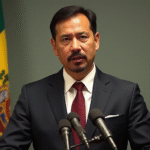Introduction to Marcelo Ebrard and His Role
Marcelo Ebrard, Mexico’s Secretary of Economy, recently highlighted the country’s potential to capitalize on the relocation of investments due to a shift away from Asia, particularly China. This change is expected to boost production in strategic industries.
Mexico’s Record-Breaking FDI Inflows
In the first quarter of 2025, Mexico reached a record $21.4 billion in Foreign Direct Investment (FDI) inflows, marking a 5.4% increase compared to the same period in 2024. Preliminary figures suggest this growth could potentially double Mexico’s FDI, with the right strategies and agreements.
Current Trade Dynamics Between Mexico and the US
Mexico faces tariffs on 25% of its exports to the US that do not meet the requirements of the United States-Mexico-Canada Agreement (USMCA). Additionally, Mexican auto exports face a 25% tariff with certain discounts and its steel and aluminum shipments also incur a 25% tariff, including derivatives of both metals.
However, Ebrard pointed out that around 86% of Mexico’s trade with the US is tariff-free, a percentage that dropped from 100% at the beginning of 2025, violating the USMCA.
Opportunities with Relocation of Investments
On the offensive side, Mexico can benefit from the relocation of investments as the US seeks to reduce its dependence on Asia, specifically China. This shift will likely increase production in strategic industries.
For instance, the US imports $300 billion worth of pharmaceuticals, while Mexico’s exports in this sector only amount to approximately $1 billion. Ebrard also mentioned Mexico’s electronics production with low national content and the potential for co-production in the semiconductor industry with the US. He emphasized the need to develop data infrastructure.
“As we progress through these stages, we will see an increasing flow of foreign investment. It’s clear that there will be an accelerated geopolitical relocation in the next three years, which can significantly benefit us,” Ebrard stressed.
Domestic Investment and Industrial Parks
Ebrard noted that there is a record of foreign investment in Mexico, and it’s crucial to understand which private projects are driving these investments.
“We have nearly 2,000 projects, the vast majority being foreign investments. Now, we’re focusing on domestic investments. This means the government’s effort is to accelerate investments in that portfolio,” he explained.
At the event, Ebrard projected another figure: the private sector has about 100 industrial parks in Mexico. The federal government recently unveiled 14 Development Poles, guaranteeing businesses access to water and electricity. “This is the logic; it’s complementary. 100 won’t be enough; we aim for perhaps more than 300,” he said.
Coordination Between Mexico and the US
Ebrard emphasized that the new US economy requires coordinated actions between Mexico and the US, a unique opportunity with a short timeline.
“There’s hardly any precedent. We need to agree on all of this,” he concluded.
Key Questions and Answers
- What is the current situation regarding FDI in Mexico? Mexico reached a record $21.4 billion in FDI inflows in the first quarter of 2025, with potential to double due to relocation of investments from Asia.
- What tariffs does Mexico currently face on its exports to the US? Approximately 25% tariffs apply to exports not meeting USMCA requirements, auto exports, and steel & aluminum shipments.
- How can Mexico benefit from the shift in investments away from Asia? By capitalizing on relocation of investments, Mexico can boost production in strategic industries, such as pharmaceuticals and electronics.
- What is the current status of domestic investments in Mexico? The Mexican government is accelerating domestic investments, with nearly 2,000 projects in the pipeline, many of which are foreign investments.
- What is the role of industrial parks in Mexico’s economic development? The private sector has around 100 industrial parks, with the federal government aiming to establish more than 300 Development Poles to support businesses.
- Why is coordination between Mexico and the US crucial in this new economic landscape? The new US economy requires joint efforts to ensure mutual benefits, with a short timeline for implementation.






